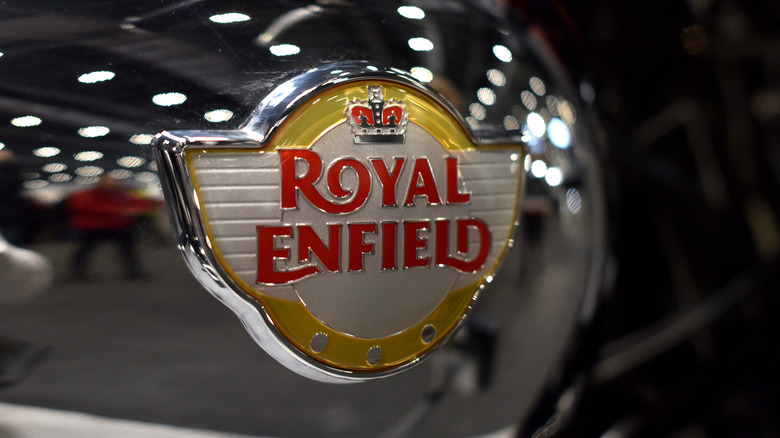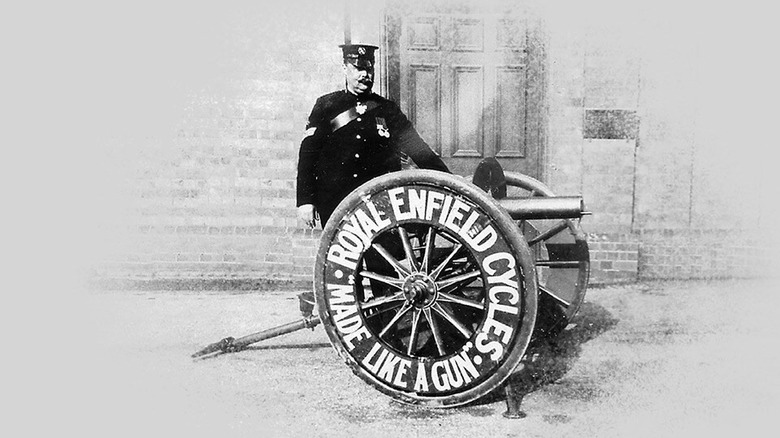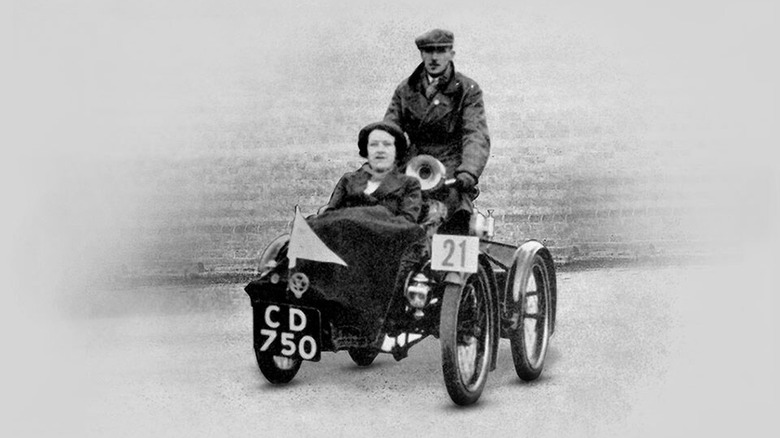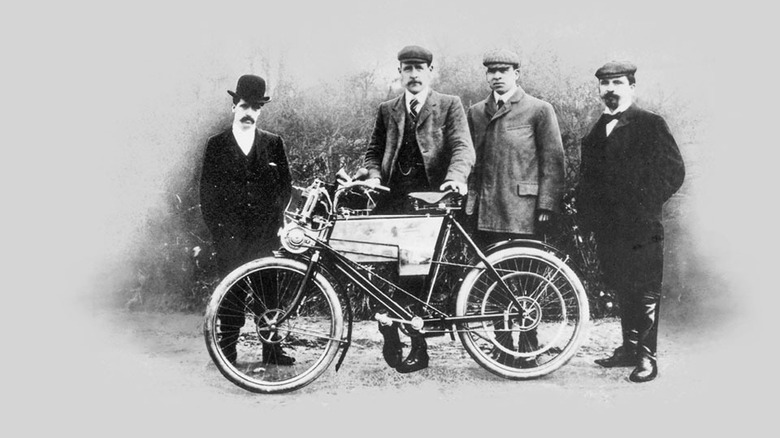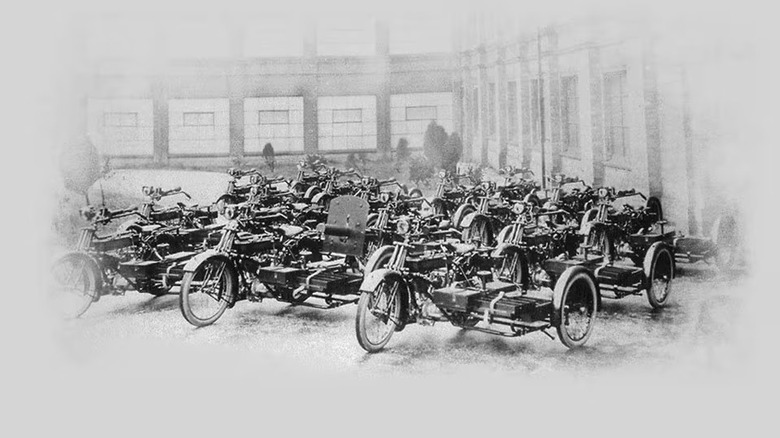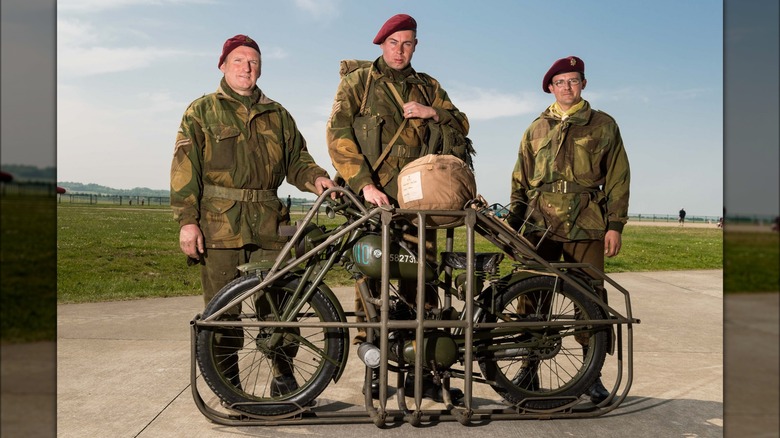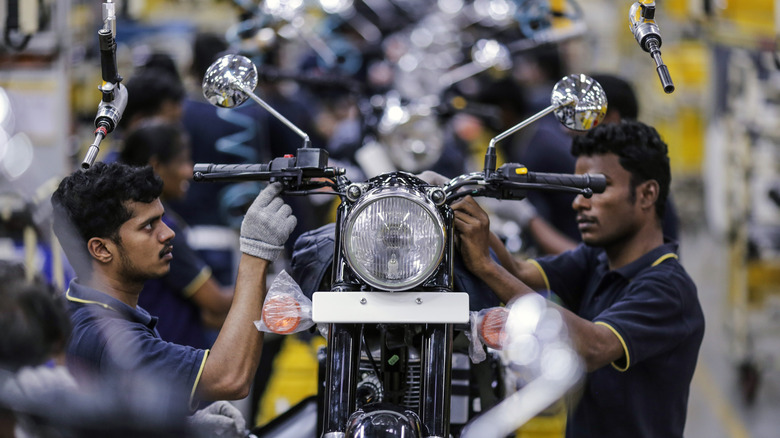The History Of Royal Enfield: The Motorcycle Company Running Over A Hundred Years
Peugeot Motorcycles is the world's oldest motorcycle manufacturer because it showed off the very first one at the 7th Cycle and Automobile Exhibition in 1898. But Royal Enfield wasn't far behind, making its first motorcycle just a few years later, in 1901. From that first gas-powered bicycle to its upcoming electric motorcycle, Royal Enfield is the oldest company still producing motorcycles.
The company started a decade earlier (November 1891), and like many car and bike makers, it didn't start off manufacturing what it would eventually become famous for. Two Englishmen — Bob Walker Smith and Albert Eadie — decided to buy an already existing company called George Townsend & Co. located in Hunt End, Redditch, a district within the county of Worcestershire, England. Yes, the same county where the world-famous and infamously hard-to-pronounce sauce comes from.
But Townsend & Co. didn't make motorcycles. In fact, for the better part of the previous half-century, it made needles for sewing machines. Around the mid-1880s, it expanded and began making bicycle parts as well. A few years later, it started building and selling whole bikes, and while it was one step closer, it was still some years off from making motorized cycles.
Smith and Eadie were awarded a contract in 1893 to make precision rifle parts for the government-owned Royal Small Arms Factory in Enfield, Middlesex. The pair, in turn, changed the company name to Enfield Manufacturing Company Ltd. and its first bicycle (designed wholly in-house by Smith) to the Enfield.
Make motorcycles like guns
This move was likely part of a bigger marketing strategy, and a smart one at that, as it more closely associated itself with the famous gun maker, and because a few years earlier (1890), the Crown had licensed the Royal Enfield name, and thus aligned itself further to the monarchy and government.
The following year (1894) was pivotal, as it renamed the bike Royal Enfields and created what would eventually become its legendary trademark slogan — "Made Like a Gun." Perhaps part of the reason the slogan became so memorable was the pair went out and bought a Maxim machine gun (the world's first fully automatic one) and turned it into a promotional prop by painting "Made Like a Gun" on the wheels.
Ironically, it was mistaken for a real working machine gun when they took it to a motorcycle show in Ireland and was summarily held by customs. As the saying goes, "There's no such thing as bad publicity," and it didn't take long for the company to garner a reputation as an exceptional engineer.
In 1898, Bob Walker Smith and Albert Eadie finally settled on a company name that would stick for the next 70 years — The Enfield Cycle Co. Ltd. During the same year, Smith created their first motorized vehicle. While this was the same year Peugeot dropped its first bike, Enfield's contraption was considered a quadricycle, not a motorcycle.
Rear wheel or front wheel drive, that was the question
The quadricycle was simply two bike frames joined together. A driver sat between the frames and used standard handlebars to steer the four-wheeled contraption, while a passenger sat in a posh seat up front. It was powered by a rear-mounted 1.5 hp De Dion engine. Three-wheeled tricycles powered by this same engine were also made.
A few years later (1900), the company entered one of its now finally honed quadricycles in a cross-country race called the 1,000 Miles Motor Vehicle Trial. It was organized by the Automobile Club of Great Britain & Ireland (which evolved into the Royal Automobile Club) to show the wider British public just how helpful and reliable motorized vehicles could be in their daily lives.
The trial, which began (on April 23) and ended in London (on May 12), wound through 1,090 miles of English roads. A total of 83 vehicles entered; 65 started, but only 35 finished. Nowhere in the records does it say if the Royal Enfield finished the trial.
Then, in 1901, the company hired Frenchman Jules Gobiet, and he and chief designer Bob Walker Smith began tinkering on its first proper motorcycle, a time when the fledgling industry debated where the engine should be mounted. Some believed it should be in front of the frame's main down tube just ahead of the sprocket and power the rear wheel, while others thought it should be attached to the steering head just above — and powering — the front wheel.
The best of both worlds
Jules Gobiet and Bob Walker Smith abandoned the tried and true rear-mounted De Dion engine for their first prototype and went with a Belgian-made Minerva. This engine was designed to easily "clip-on" to the bike's frame in front of the main down tube and power the rear wheel. They took this prototype, two quadricycles, a tricycle, and one other motorized bike to the Stanley Cycle Show in London in November 1901. That second "motor bicycle," however, shook things up.
Gobiet wanted to lessen the risk of side slippage associated with the front-wheel drive layout. So, he used a front-mounted 1.5 hp motor, but instead of connecting it to the front wheel (as convention had it), he attached a long crisscrossing rawhide belt extended down and back to the rear wheel. And voilà, they had the best of both worlds. The design was such a hit that it became known as the original Royal Enfield motorcycle.
Over the next decade, the company continued to upgrade and innovate. In 1902, it built a water-cooled 239-cc engine producing 2.75 hp. This bike weighed 140 pounds and had a top speed of 30 mph. The following year (1903), it created a chain-driven model. Six years later (1909), it shook the industry again, this time by designing its first V-twin powered by a 297-cc (2.25 hp) Motosacoche Swiss-made engine. This bike won several competitions, including the grueling long-distance endurance race called the John O' Groats to Lands End Trial (LEJOG).
WWI brought the slogan full circle
Its 1912 model featured a significant boost in power from its previous engines, boasting a J.A.P. (J.A. Prestwich) 770-cc V-twin kicking out six horsepower. Available with a sidecar attachment, this bike made "Enfield a household name" in England.
When World War I began in June 1914, everything changed. The company supplied motorcycles for several armies, including the British, Belgian, French, United States, and Russia, which, when used with the sidecar attachment, acted as an ambulance; others, ironically, attached a Maxim machine gun.
Enfield built bikes using its custom three-horsepower engines coated in the now standard black paint scheme with a green gas tank trimmed in gold paint. It also began full-scale production of its first two-stroke motorcycle. A year after the war ended (1919), civilian production resumed, but only two models were offered.
By 1924, the company was back to selling eight different bikes, including a sidecar version now powered by an eight horsepower Vickers engine, a 225-cc two-stroke step-through "Ladies Model," and the Sports Model 351 — its first 350-cc OHV 4-stroke bike, complete with a foot-operated gear changer.
Despite a massive fire that nearly wiped out the plant in 1925, the company continued to innovate and became one of the first to move away from the front fork system to center-sprung girder-type forks. It also began using new and improved saddle tanks instead of flat tanks.
The iconic Bullet and the Flying Flea
Even the Great Depression, experienced by nearly every country around the globe during the '30s, didn't seem to dent Royal Enfield's ability to evolve. In 1932, it built the first "Bullet" in three different models (250, 350, and 500-cc) sporting a sloper-style inclined engine with high compression pistons, twin-ported cylinder heads, and a foot-operated gear changer. This bike is still being built today and is considered one of the best Royal Enfields ever.
The very next year (1933), it dropped the way outside-the-box designed Model Z "Cycar." This 148-cc two-stroke fully enclosed bike had protective legshields and was marketed squarely to commuters.
During World War II, the company manufactured more than just motorcycles and bicycles for the British army; it also built generators and anti-aircraft gun predictors (an early analog version of a computerized firing control system that helped aim anti-aircraft guns). Of all the motorcycles made by Royal Enfield during this time, the most recognizable was the WD/RE "Flying Flea," a lightweight 126-cc two-stroke machine that could be fitted into special air-drop crates and parachuted in behind enemy lines to be used by British paratroopers.
In '48, the first post-war 350-cc Bullet prototype was designed featuring an oil-dampened swingarm rear suspension. It went into production in the U.K. the following year (along with a 500 Twin), with both models using similar components, including the frame, swingarm suspension, telescopic front forks, and gearbox.
Enfield remains true motorcycle royalty
The company's official connection with India began in 1949 when Madras Motors (helmed by K. R. Sundaram Iyer) started importing British bikes (Royal Enfield among them) into India. Over time, it became well respected for being easy to maintain and very robust. In 1952, the government ordered 500 of the 350-cc Bullets for the police and army.
That was followed in 1955 with another order of 800, precipitating a business partnership between Redditch and Madras Motors. Enfield India was formed, giving it a majority of stock shares and the license to build Bullets. At first, kits were sent from Redditch to India for assembly, but in 1957, Enfield India bought equipment to build bikes from scratch, thus cementing the Bullet's popularity in India.
The Continental GT café racer dropped in 1964, but a few years later, only two bikes (the Continental and Interceptor) were still being built in England, so the company closed down and sold the Redditch plant (in 1967). Bike production was moved to its facility in Avon until that one closed in June 1970, but not all was lost. By 1977, Royal Enfield India was exporting the Bullet back to Europe, creating a new cult following within British motorcycle groups.
A second cutting-edge facility was built in India in 2013, which continues to build motorcycles today (some of which are surprisingly cheap to buy, by the way). Royan Enfield is, without a doubt, a true motorcycle royalty.
